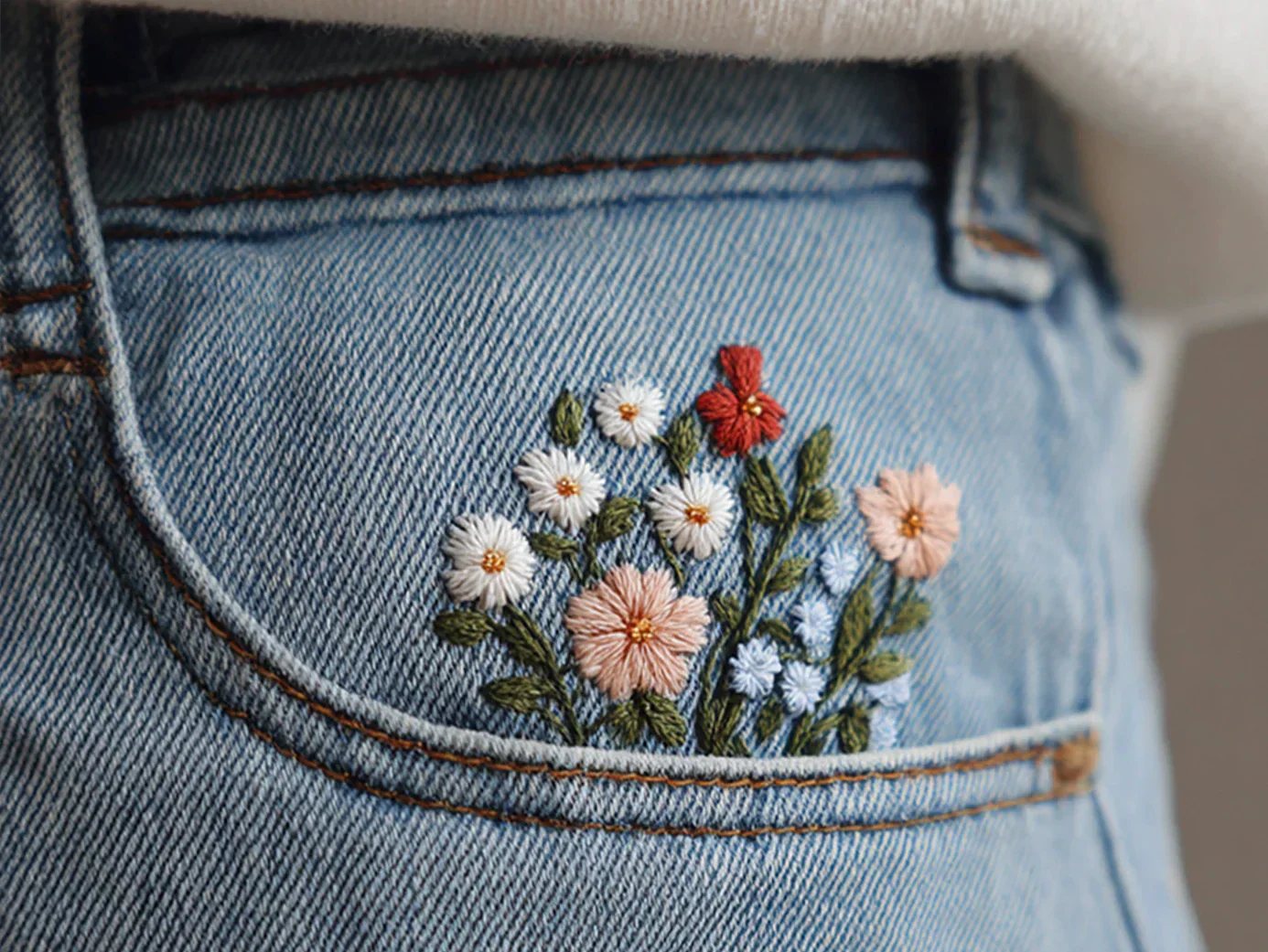
Proper care ensures your embroidered pieces remain beautiful for decades. Follow these simple steps to protect your handwork investment.
Washing Embroidered Clothes
Before First Wash
Test colorfast threads: Dampen cotton swab, gently dab thread. If color transfers, hand wash separately until water runs clear.
Check thread security: Gently tug loose thread ends. Secure any that feel loose before washing.
Machine Washing
Turn inside out: Protects embroidery from friction and snagging Use cold water: Prevents thread bleeding and fabric shrinkage
Gentle cycle: Reduces agitation that can damage stitches Mild detergent: Avoid bleach or fabric softeners that weaken threads Mesh laundry bag: Extra protection for delicate embroidered pieces
Hand Washing (Best for Delicate Work)
- Fill basin with cold water and gentle detergent
- Submerge garment, gently swish for 2-3 minutes
- Don't scrub embroidered areas directly
- Rinse thoroughly in clean cold water
- Press out water gently—never wring
Drying Your Embroidered Pieces
Never wring or twist: This distorts stitches and fabric Lay flat to dry: Prevents stretching and maintains shape Away from direct heat: Avoid direct sunlight, radiators, or heat vents Reshape while damp: Gently adjust garment to original shape Air dry completely: Ensures no moisture remains in thick embroidered areas
Ironing and Pressing
Safe Ironing Method
- Iron inside out: Protects embroidery surface from heat damage
- Use pressing cloth: Place thin cotton cloth between iron and fabric
- Medium heat: Adjust based on base fabric requirements
- Press, don't slide: Lifting motion prevents thread snagging
- Avoid direct contact: Never iron directly on embroidery surface
For Raised Embroidery
Towel method: Place embroidered piece face-down on thick towel, iron back side. Towel cushions raised stitches.
Storage Tips
Clean before storing: Wash and dry completely to prevent stains setting Flat storage ideal: Prevents permanent creases in embroidered areas Cedar protection: Use cedar blocks (not mothballs) for natural pest protection
Breathable storage: Cotton garment bags or acid-free tissue paper Avoid plastic: Traps moisture that can cause mildew
Handling Minor Repairs
Loose Threads
Don't pull: Gently push loose thread to back side with needle tip Secure immediately: Tie off loose ends or re-stitch small areas Match thread carefully: Use same brand/color for invisible repairs
Small Snags
Gentle approach: Use needle to work snag back through fabric Don't cut: Cutting can create larger holes Professional help: For valuable pieces, consult textile restoration expert
Extending Embroidered Garment Life
Rotate wearing: Don't wear same embroidered piece repeatedly Spot clean when possible: Address small stains without full washing Proper hanging: Use padded hangers for structured embroidered garments Regular inspection: Check for loose threads or wear patterns monthly
Special Care for Different Fabrics
Cotton/Linen Embroidery
- Machine wash cold, gentle cycle
- Can handle slightly higher iron heat
- Reshape while damp for best results
Delicate Fabrics (Silk, Wool)
- Hand wash only with appropriate detergent
- Professional cleaning for valuable pieces
- Store flat with acid-free tissue
Knit Fabrics with Embroidery
- Extra gentle handling to prevent stretching
- Dry flat always—hanging distorts shape
- Use lower iron heat to prevent melting
Troubleshooting Common Issues
Puckering after washing: Steam gently while reshaping, or dampen and lay flat with light stretching
Thread bleeding: Rinse immediately in cold water, treat stain before it sets
Embroidery flattened: Steam hover (don't touch) to restore dimension
Fabric shrinkage: Prevention is key—always wash in cold water
When to Seek Professional Help
- Valuable vintage embroidered pieces
- Extensive staining or damage
- Antique threads requiring special handling
- Museum-quality or heirloom pieces
Care Schedule
After each wear: Check for loose threads, spot clean if needed Every 3-4 wears: Full wash following care instructions Seasonally: Deep inspection, proper storage preparation Annually: Professional assessment for valuable pieces
Investment Protection
Proper care turns embroidered clothes into:
- Family heirlooms passed down generations
- Wardrobe investments lasting 10+ years
- Artistic pieces maintaining beauty over time
- Sustainable choices reducing replacement needs
Your embroidered pieces represent hours of creative work—protect that investment with proper care techniques.


